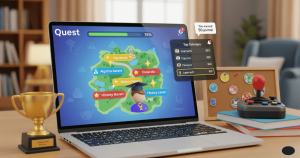How to Use LinkedIn Learning Groups to Promote Your Courses

Course creators and educators face a constant challenge: reaching the right learners in an increasingly crowded online education market. While many focus on traditional marketing channels, LinkedIn Learning Groups offer an untapped goldmine for promoting educational content to highly engaged, professional audiences.
LinkedIn Learning Groups represent specialized communities where professionals come together to discuss industry trends, share knowledge, and enhance their skills. These groups provide course creators with direct access to motivated learners who actively seek professional development opportunities. Unlike broad social media platforms, LinkedIn Learning Groups attract members with specific learning goals and professional aspirations.
The strategic advantage lies in the quality of engagement rather than quantity. Members intentionally join these groups, seeking valuable educational resources and networking opportunities. This creates an ideal environment for course promotion when approached authentically and with a value-first approach.
Understanding LinkedIn Learning Groups
LinkedIn Learning Groups function as professional communities centred around specific industries, skills, or career development topics. These groups range from broad categories, such as “Digital Marketing Professionals,” to niche specializations, including “Advanced Data Analytics for Healthcare.”
Group membership typically includes working professionals, career changers, students, and industry experts. Members actively participate in discussions, share resources, and seek recommendations for courses and certifications. This engaged audience represents your ideal target market for online education marketing.
The platform’s professional context sets LinkedIn Learning Groups apart from other social networks. Members approach these spaces with a learning mindset, making them more receptive to educational content and course recommendations when presented in a clear and appropriate manner.
Building Your Presence in Learning Communities

Success in LinkedIn Learning Groups begins with authentic community participation. Begin by joining groups that align with your course topics and areas of expertise. Focus on 5-7 highly active groups rather than joining dozens that offer little to no meaningful engagement.
Establish credibility by contributing valuable insights to discussions before promoting any courses. Answer questions thoughtfully, share relevant industry knowledge, and consistently participate in conversations. This foundation builds trust and positions you as a knowledgeable community member rather than a salesperson.
Craft a compelling LinkedIn profile that effectively conveys your educational expertise. Include relevant credentials, course creation experience, and specific achievements in your field. Group members often review profiles before engaging with your content, making this professional presentation crucial.
Monitor group activity patterns to understand peak engagement times and popular discussion topics. This intelligence helps you time your contributions effectively and align your content with community interests.
Effective Strategies for Course Promotion
Direct course promotion should account for only a small fraction of your group’s activity. The most successful approach follows the 80/20 rule: 80% valuable content contribution and 20% subtle promotion.
Share educational snippets from your courses as helpful tips or insights. For example, if you teach project management, post a useful framework or methodology that gives group members immediate value while demonstrating your expertise. Include a mention that this concept is derived from your comprehensive course for those seeking deeper learning.
Participate in recommendation threads where members ask for course suggestions. These opportunities allow natural course mentions when your content genuinely matches the request. Always provide context about why your course fits their specific needs rather than a generic promotion.
Create discussion posts that encourage engagement around topics covered in your courses. Ask thought-provoking questions, share industry observations, or request feedback on emerging trends. These posts build community engagement while subtly establishing your subject matter authority.
Offer exclusive group benefits such as discount codes or free course modules. Frame these offers as a gesture of appreciation for the community, rather than sales pitches. Limited-time offers create a sense of urgency while rewarding active group members.
Content Strategies That Drive Engagement
Successful online education marketing in LinkedIn Learning Groups requires content that educates while subtly promoting the brand. Share bite-sized learning resources that demonstrate your teaching style and expertise.
Case studies work exceptionally well in professional groups. Share real examples from your courses or student success stories (with permission). These narratives showcase practical applications of your teaching while building credibility through social proof.
Industry trend analysis positions you as a thought leader while creating natural opportunities to mention relevant course content. Discuss emerging skills, changing job requirements, or new technologies, connecting these insights to your educational offerings.
Interactive content generates high engagement in learning communities. Create polls about learning preferences, skill challenges, or industry developments. Use results to spark discussions that naturally incorporate your course topics.
Behind-the-scenes content, such as course creation, teaching methodologies, or educational philosophy, humanizes your brand while demonstrating expertise. Members appreciate transparency about the learning design process.
Dig Deeper: Best Social Media Platforms for Online Course Promotion
Measuring Success and Optimizing Your Approach

Track specific metrics to evaluate the effectiveness of your LinkedIn Learning Groups strategy. Monitor profile visits, connection requests, course page views, and enrollment conversions from group activities.
Engagement quality matters more than quantity. Focus on meaningful conversations, genuine questions about your expertise, and private messages from interested learners rather than just likes and comments.
Survey new students about how they discovered your courses. This feedback reveals which group activities and content types drive actual enrollments rather than just engagement.
Test different promotion approaches across various groups to identify what resonates with different professional communities. Technical groups might prefer detailed methodology discussions, while leadership groups respond better to strategic frameworks.
Document successful content formats and topics for replication across groups. Build a content library of proven discussion starters, helpful resources, and promotional approaches.
Avoiding Common Pitfalls
Excessive promotional behavior can quickly damage your reputation in LinkedIn Learning Groups. Group administrators and members actively discourage spam-like promotion. Focus on building relationships and consistently providing value.
Generic course promotion across multiple groups appears inauthentic and reduces engagement. Customize your approach for each community’s specific interests and professional focus areas.
Neglecting group rules and guidelines can result in the removal of posts or termination of membership. Carefully review each group’s promotion policies and community standards before participating.
Inconsistent participation undermines relationship-building efforts. Sporadic activity makes you appear opportunistic rather than genuinely invested in the community.
Maximizing Your LinkedIn Learning Impact
LinkedIn Learning Groups offer course creators an invaluable opportunity to connect with motivated professional learners. Success requires authentic community participation, valuable content contribution, and strategic course promotion that prioritizes relationships over sales.
The key lies in viewing these groups as long-term relationship-building platforms rather than quick promotional channels. By consistently providing value and establishing expertise, you create natural opportunities for course promotion that feel organic to the community.
Start by joining 3-5 relevant groups today. Spend the first month observing conversations, understanding community dynamics, and contributing helpful insights without any promotion. This foundation sets the stage for sustainable growth through LinkedIn Learning Groups.
Remember that online education marketing success stems from consistently building trust and demonstrating value. LinkedIn Learning Groups offer the ideal environment for both when approached with authenticity and a genuine commitment to community success.
Frequently Asked Questions
How often should I promote my courses in LinkedIn Learning Groups?
Aim for subtle course mentions in no more than 10-20% of your group contributions. Focus primarily on providing valuable insights and building relationships rather than direct promotion.
Which types of LinkedIn Learning Groups work best for course promotion?
Target active groups with 1,000 to 10,000 members in your subject area. Smaller groups offer more personal connections, while larger groups provide broader reach. Industry-specific groups often convert at a higher rate than general education groups.
How do I handle negative responses to course promotion?
Address concerns professionally and transparently. If community members question your approach, acknowledge their feedback and adjust your strategy. Authentic responses often build more trust than defensive reactions.
Can I create my own LinkedIn Learning Group for course promotion?
Yes, but building an active community requires significant time investment. Focus on providing consistent value to attract and retain members. Use your group to complement rather than replace participation in established communities.



